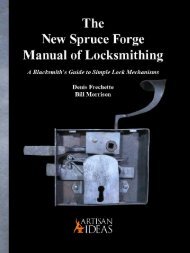FORGED: Making a Knife with Traditional Blacksmith Skills
This book will teach you to hand build a knife using the traditional method of blacksmiths of old — FORGING. Traditional forging of a knife blade is a process which uses the ancient techniques of moving hot steel with hammer and anvil alone into a knife-form that is ready for filing, heat treating and sharpening with no or very minimal electric grinding. This book also teaches traditional fit-and-finish skills using only hand tools. It explains an ancient riveted full-tang handle construction system that surpasses modern methods. In the author's words; "In my early blacksmithing years, I was lucky to get to know some old smiths who wrangled hot iron every day just to make a living. They unselfishly taught me traditional blacksmithing skills and knife forging methods. Every time I use those skills and methods, I honor their friendships, and by teaching you, the reader, we keep alive the memory of those old-time iron pounders." Hardcover, 132 pages, 150 photos and illustrations, $29.95.
This book will teach you to hand build a knife using the traditional method of blacksmiths of old — FORGING.
Traditional forging of a knife blade is a process which uses the ancient techniques of moving hot steel with hammer and anvil alone into a knife-form that is ready for filing, heat treating and sharpening with no or very minimal electric grinding.
This book also teaches traditional fit-and-finish skills using only hand tools. It explains an ancient riveted full-tang handle construction system that surpasses modern methods.
In the author's words; "In my early blacksmithing years, I was lucky to get to know some old smiths who wrangled hot iron every day just to make a living. They unselfishly taught me traditional blacksmithing skills and knife forging methods. Every time I use those skills and methods, I honor their friendships, and by teaching you, the reader, we keep alive the memory of those old-time iron pounders."
Hardcover, 132 pages, 150 photos and illustrations, $29.95.
You also want an ePaper? Increase the reach of your titles
YUMPU automatically turns print PDFs into web optimized ePapers that Google loves.
The <strong>Blacksmith</strong><br />
Paul White has been a blacksmith for over forty years. The smith who taught<br />
Paul to make his frontier style blade was Gus Marie of Brownsville, Illinois.<br />
Gus simply called his blade a work knife and so does Paul. The knife industry<br />
romanticizes this blade style by calling it a “Frontier” or “Bush <strong>Knife</strong>”. Gus was<br />
the last of an unbroken chain of blacksmiths, originally from France, who came<br />
to the Colonies before the American Revolution.<br />
Paul’s other early mentors were Evan Cooper, an original cowboy from Utah that<br />
shod his own horses, made his own knives and branding irons, and repaired his<br />
own wagons; a real “throwback” kind of guy. The Deal brothers, Jim and Ben,<br />
both blacksmiths of Murphysboro Illinois, trained as rural smiths at Tuskegee<br />
College after the first Great War. They allowed Paul to “hang around their shop”<br />
helping out. Paul was also proud to have worked <strong>with</strong> Daryl Meier and Brent<br />
Kington of Southern Illinois University. Both men ushered in this modern era<br />
of blacksmithing and pattern-welded steel that we all enjoy. They too were an<br />
early and significant influence on Paul’s traditional training and approach to<br />
blacksmithing. Paul has treasured his friendships <strong>with</strong> these “old” smiths as<br />
much as the lessons they taught. Relocating to Northern Illinois in 1978 Paul<br />
was instrumental in establishing, equipping, teaching and demonstrating at the<br />
smith shop at Midway Village Museum in Rockford, Illinois. For many years he<br />
taught classes in general blacksmithing, Colonial hardware and, of course, knife<br />
making. He now limits his teaching to individual smiths seeking that traditional<br />
approach to blacksmithing passed-on to him from those legendary smiths of the<br />
last century. He has learned what works and what doesn’t in teaching others to<br />
build a knife. He has captured those old-time secrets in this book and wants to<br />
see other smiths enjoy traditional blacksmithing as much as he does. Paul is an<br />
old-time guy, teaching an old-time skill to make an old-time tool.<br />
Any traditional craftsman will quickly tell you that the best way not to form bad<br />
habits is to learn new skill sets from an expert. Paul’s methods will get you off to<br />
an excellent start in learning the ancient craft of blacksmithing and the artistry of<br />
knife-making. The skills gleaned from making the Frontier can then be utilized<br />
in making any style blade in the knife inventory.<br />
129










